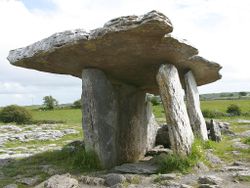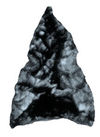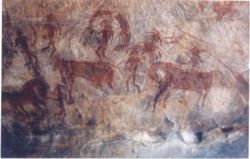Stone Age
2007 Schools Wikipedia Selection. Related subjects: Ancient History, Classical History and Mythology
The Stone Age is a period of history that encompasses the first widespread use of technology in human evolution and the spread of humanity from the savannas of East Africa to the rest of the world. It ends with the development of agriculture, the domestication of certain animals and the smelting of copper ore to produce metal. It is termed prehistoric, since humanity had not yet started writing -- the traditional start of history (i.e. recorded history).
Human development during the Stone Age
The Stone Age covers an immense time span, and during this period major climatic and other changes occurred, which affected the evolution of humans. Humans themselves evolved into their current morphological form during the later period of the Stone Age.
Epipalaeolithic/Mesolithic
The period between the end of the last ice age, 10,000 years ago to around 6,000 years ago, is characterised by rising sea levels and a need to adapt to a changing environment and find new food sources. The development of microlith tools began in response to these changes. They were derived from the previous Palaeolithic tools, hence the term Epipalaeolithic. However, in Europe the term Mesolithic (Middle Stone Age) is used, as the tools (and way of life) was imported from the Near East. There, microlith tools permitted more efficient hunting, while more complex settlements, such as Lepenski Vir developed based around fishing. Domestication of the dog as a hunting companion probably dates to this period...
Neolithic
The Neolithic (New Stone Age) is characterised by the adoption of agriculture (the so-called Neolithic Revolution), the development of pottery and more complex, larger settlements such as Çatal Hüyük and Jericho. The first Neolithic cultures started around 8000 BC in the fertile crescent. Agriculture and the culture it led to spread to the Mediterranean, the Indus valley, China, and Southeast Asia.
Due to the increased need to harvest and process plants, ground stone and polished stone artefacts became much more widespread, including tools for grinding, cutting, chopping and adzing. The first large-scale constructions were built, including settlement towers and walls (e.g., Jericho) and ceremonial sites (e.g., Stonehenge). These show that there was sufficient resources and co-operation to enable large groups to work on these projects. To what extent this was the development of elites and social hierarchies is a matter of on-going debate. The earliest evidence for established trade exists in the Neolithic with newly settled people importing exotic goods over distances of many hundreds of miles. Skara Brae located on Orkney island off Scotland is one of Europe's best examples of a neolithic village. The community contains stone beds, shelves, and even an indoor toilet linked to a stream.

Stone Age material culture
Food and drink
Food sources of the hunter-gatherer humans of the Stone Age included both animals and plants that were part of the natural environment in which these humans lived. These humans liked animal organ meats, including the liver, kidneys, and brains. They consumed little dairy food or carbohydrate-rich plant foods like legumes or cereal grains.
Current research indicates that two-thirds of the energy was derived from animal foods. The fat content of the diet was believed to be similar to that of the present day, but the ratio of the types of fats consumed differed: the Omega-6 to Omega-3 ratio was about 3:1 compared to 12:1 of today.
Near the end of the last ice age, 15,000 to 9,000 years ago, a large scale extinction of large mammals (the mammalian megafauna) occurred in Asia, Europe, North America and Australia. This was the first Holocene extinction event. This event possibly forced modification in the dietary habits of the humans of that age and with the emergence of agricultural practices, plant-based foods also became a regular part of the diet.
A report in the National Geographic News indicated that "the first wine-tasting may have occurred when Neolithic humans slurped the juice of naturally fermented wild grapes from animal-skin pouches or crude wooden bowls."
Shelters and habitats
Around 2 million years before present, Homo habilis is believed to have constructed first man-made structure in East Africa, consisting of simple arrangements of stones to hold branches of trees in position. A similar stone circular arrangement believed to be around 500,000 years old was discovered at Terra Amata, near Nice (France). Several human habitats dating back to the Stone Age have been discovered in different parts of the earth, including:
- A tent-like structure inside a cave near the Grotte du Lazaret, Nice, France.
- A structure with roof supported with timber, discovered in Dolni Vestonice, Czechoslovakia, dates to around 23,000 BC. The walls were made of packed clay blocks and stones.

- Many huts made of mammoth bones were found in Eastern Europe and Siberia. The people who made these huts were specialised mammoth hunters. Examples have been found along the Dniepr river valley of Ukraine, including near Chernihiv, in Moravia (in the Czech Republic) and in southern Poland.
- An animal hide tent dated to around 15,000 to 10,000 BC (in the Magdalenian) was discovered at Plateau Parain, France.
- Megalithic tombs, multi-chambered, and dolmens, single-chambered, were graves with a huge stone slab stacked over other similarly large stone slabs. They have been discovered all across Europe and Asia, and were built in the Neolithic. Several tombs with copper and bronze tools have also been discovered, illustrating the problems of attempting to define periods based on technology.
Art
Pre-historic art can only be traced from surviving artefacts. Prehistoric music is inferred from found instruments, while parietal art can be found on rocks of any kind. The latter are petroglyphs and rock paintings. The art may or may not have had a religious function.
Rock paintings
Rock paintings were painted on rock and were more naturalistic depictions than petroglyphs. In paleolithic times, the representation of humans in cave paintings was rare. Mostly, animals were painted: not only animals that were used as food but also animals that represented strength like the rhinoceros or large cats (as in the Chauvet Cave). Signs like dots were sometimes drawn. Rare human representations include handprints and half-human/half-animal figures. The Cave of Chauvet in the Ardèche département, France, contains the most important preserved cave paintings of the paleolithic era, painted around 31,000 BC. The Altamira cave paintings in Spain were done 14,000 to 12,000 BC and show, among others, bisons. The hall of bulls in Lascaux, Dordogne, France, is one of the best known cave paintings from about 15,000 to 10,000 BC.
The meaning of the paintings remains unknown. The caves were not in an inhabited area, so they may have been used for seasonal rituals. The animals are accompanied by signs which suggest a possible magic use. Arrow-like symbols in Lascaux are sometimes interpreted as calendar or almanac use. But the evidence remains inconclusive. The most important work of the Mesolithic era were the marching Warriors, a rock painting at Cingle de la Mola, Castellón in Spain dated to about 7,000–4,000 BC. The technique used was probably spitting or blowing the pigments onto the rock. The paintings are quite naturalistic, though stylized. The figures are not three-dimensional, even though they overlap.
Stone Age rituals and beliefs
Modern studies and the in-depth analysis of finds dating from the Stone Age indicate certain rituals and beliefs of the people in those prehistoric times. It is now believed that activities of the Stone Age humans went beyond the immediate requirements of procuring food, body coverings, and shelters. Specific rites relating to death and burial were practiced, though certainly differing in style and execution between cultures. Other rituals included birth, puberty, and marrige. Several Stone Age-dated sites in different parts of the world indicate traces of dancing, dancing in files, and initiation rites.
Remnants of Stone Age living in modern times
Anthropologists have used several tribes to study and interpret what life during the Stone Age might have been like. Such tribes can be found in Papua New Guinea, Andaman and Nicobar Islands (India), Philippines, Africa and South America.
The Stone Age in popular culture
As a slang term, "Stone Age" can be used to describe a modern civilization or group of people that live in relatively primitive conditions, even though its use is often a misnomer. The phrase "bomb them back into the Stone Age" implies a fierce attack that utterly destroys its target's infrastructure, forcing its survivors to revert to primitive technology in order to survive.
The image of the caveman is commonly associated with the Stone Age. For example, the 2003 documentary series showing the evolution of humans through the Stone Age was called Walking with Cavemen, although only the last programme showed humans living in caves. While the idea that human beings and dinosaurs coexisted is sometimes portrayed in cartoons, films, and computer games, such as The Flintstones and One Million Years B.C., the notion of primates and dinosaurs co-existing is simply a conceit of fiction and only seriously held by Young Earth creationism.
Other depictions of the Stone Age include the best-selling Earth's Children series of books by Jean M. Auel, which are set in the Palaeolithic and are loosely based on archaeological and anthropological findings. The 1981 movie Quest for Fire by Jean-Jacques Annaud tells the story of a group of humans searching for their lost fire.


